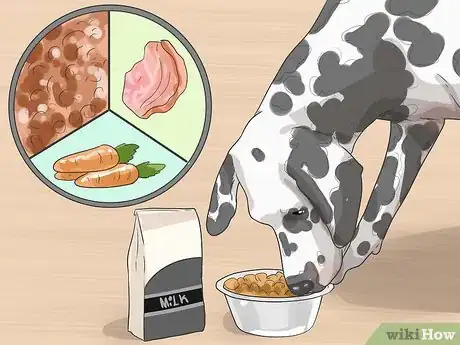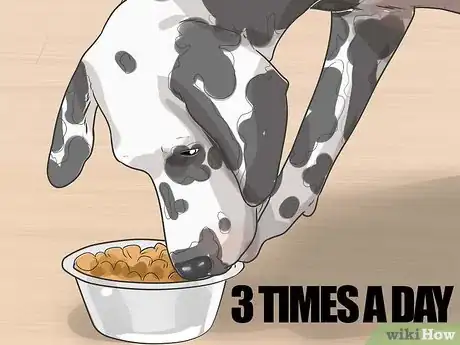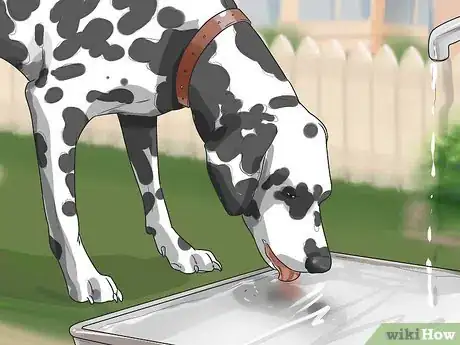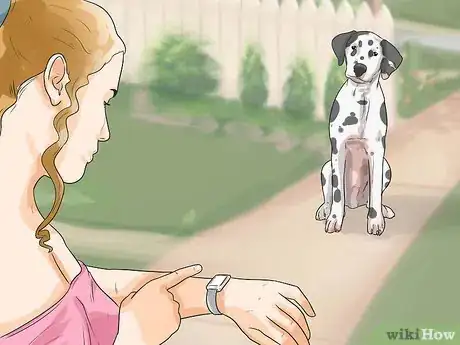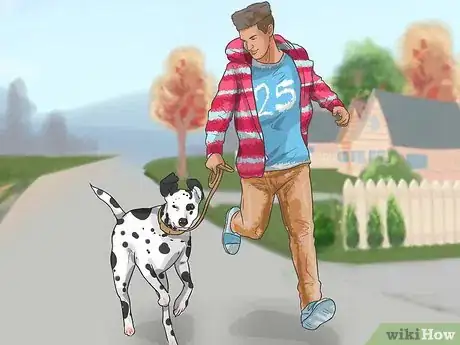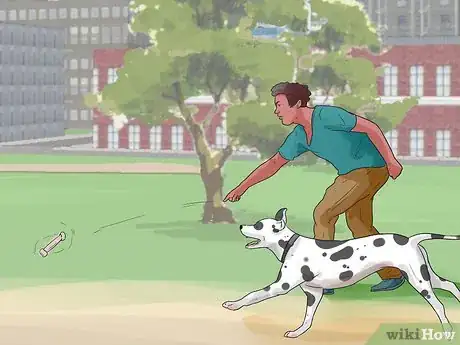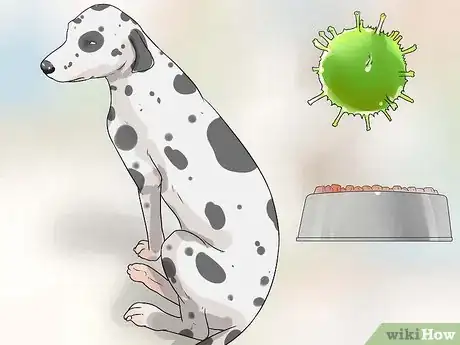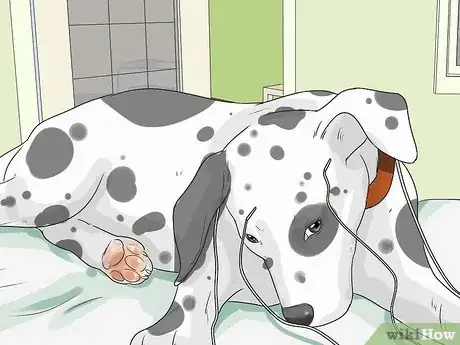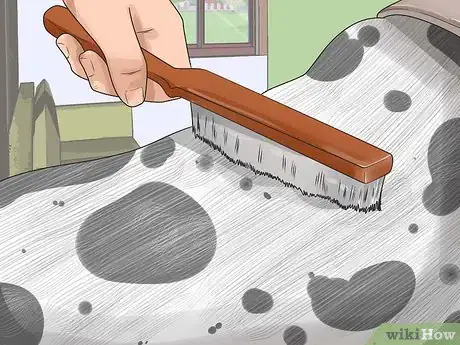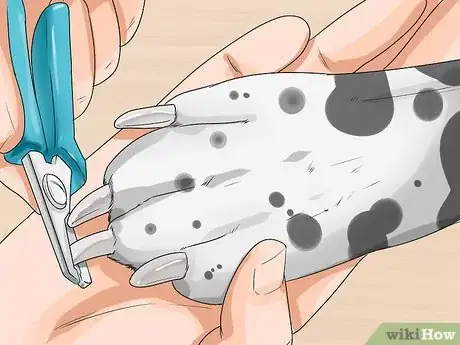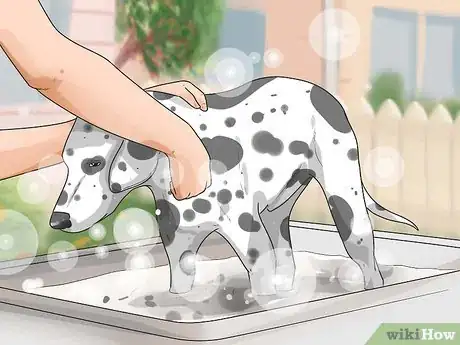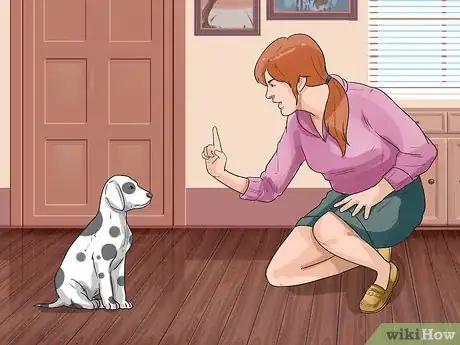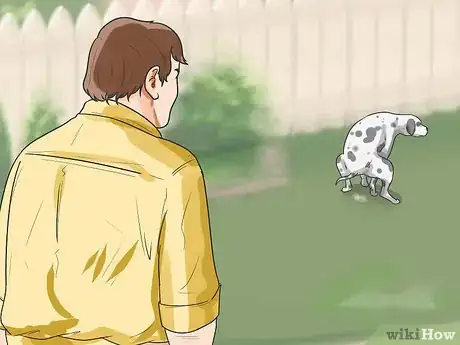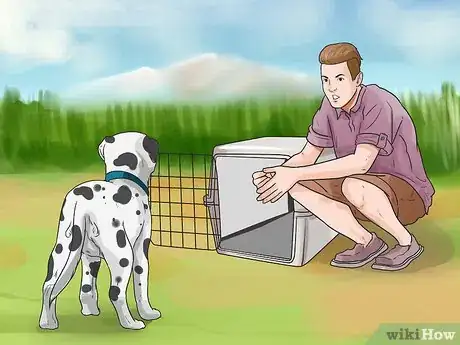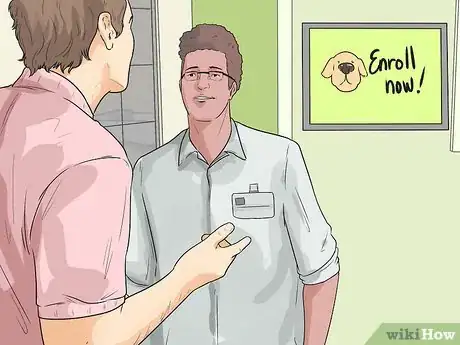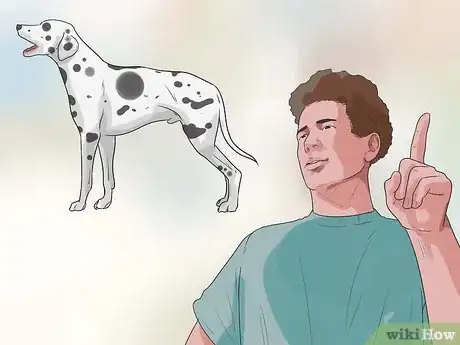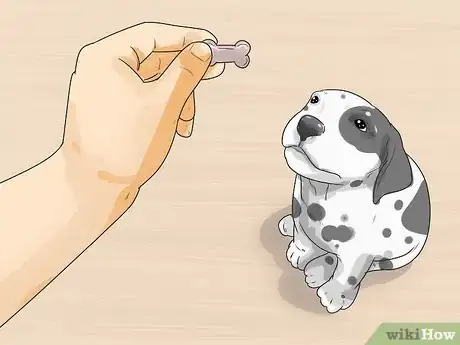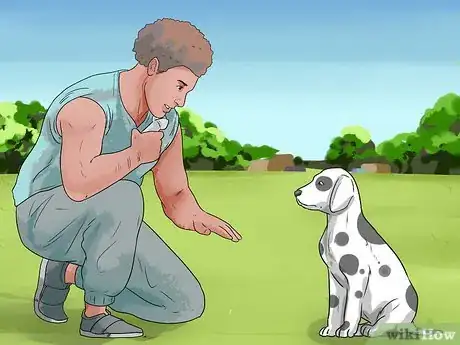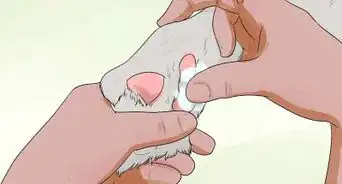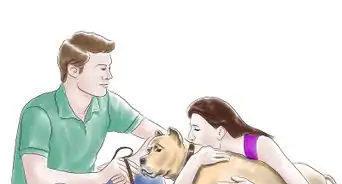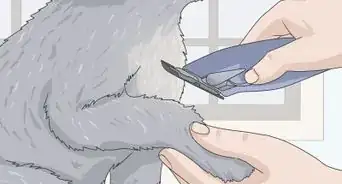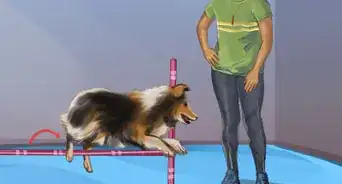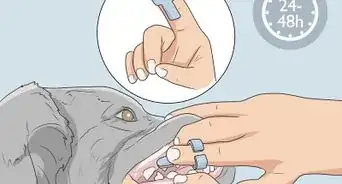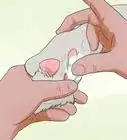This article was co-authored by Amanda Marshall-Polimeni. Amanda Marshall-Polimeni is a Dog Behavior Consultant and the Owner/Founder of FurryTales in New Jersey. With a deep understanding of behavioral learning theories and a passion for the physical and psychological well-being of animals, Amanda specializes in using non-coercive, reinforcement-based approaches to generate desired behaviors. Amanda holds a BASc in Applied Psychology from NYU and is a Certified Professional Dog Trainer - Knowledge Assessed (CPDT-KA) and Certified Behavior Consultant Canine (CBCC-KA). She has also completed a Master’s Course in Aggressive Dog Training. Her initiative and dedication to quality, comprehensive animal care at FurryTales led to her recognition by Grow by Acorns + CNBC.
There are 17 references cited in this article, which can be found at the bottom of the page.
wikiHow marks an article as reader-approved once it receives enough positive feedback. In this case, 93% of readers who voted found the article helpful, earning it our reader-approved status.
This article has been viewed 68,340 times.
Dalmatians are dogs that originated in Dalmatia (a province of Croatia). They are famous for being associated with firefighters, Dodie Smith novels, and Disney movies. Dalmatians are also athletic, high-energy dogs that love being around people and are well-suited for families.[1] [2] If you are thinking about owning a Dalmatian, take some time to learn about how to care for one so you can be the best dog owner you can be for your dog.
Steps
Feeding Your Dalmatian
-
1Feed your Dalmatian a low-purine diet. Purines are a substance that, when not metabolized properly, contribute to the formation of urate crystals in your Dalmatian’s urinary tract. Avoid beef and organ meats, like liver and kidney, which are high in purines. Instead, feed your Dalmatian a good quality diet that includes lamb, poultry, and eggs, which are lower in purine.[3]
- If your dog develops bladder stones, it may need even stricter protein restrictions to reduce the risk.
- Ask your veterinarian what diet they recommend for your Dalmatian. They may recommend that you feed your Dalmatian a low-protein diet only if he starts developing urinary problems.[4]
- Dalmatians are also prone to allergies. Avoid multi-colored foods, since they have additives that could cause or aggravate your Dalmatian’s allergies.[5]
-
2Establish a feeding schedule for your Dalmatian. If you have a Dalmatian puppy, feed him 3 times a day. Allow a few hours between his last meal and his bedtime to give him time to digest his food before going to sleep for the night.[6] Remember that he will need to go to the bathroom 45 minutes after he eats.
- When your puppy is 14 to 16 weeks old, start feeding him twice a day—once in the morning and once in the evening.[7]
- Follow the feeding instructions on the food label to determine how much you should feed your puppy per day.
- Your adult Dalmatian should eat 1.5 to 2 cups of high-quality dog food per day, split between two meals.[8]
- Dalmatians tend to eat quickly, and, if given the chance, would eat to their heart’s content. It is better for Dalmatians to have designated feeding times, rather than being allowed to eat free choice.[9] [10]
Advertisement -
3Give your Dalmatian unlimited access to fresh water. Since Dalmatians are prone to developing urinary stones, they need to drink water constantly to flush out their urinary system. Whether your Dalmatian is in a crate or can roam your house freely, make sure he has plenty of water to drink.[11]
- Given how much water your Dalmatian has to drink, he may need to urinate more frequently.
Exercising Your Dalmatian
-
1Schedule daily exercise with your Dalmatian. Dalmatians are athletic and full of energy. Without an outlet for all of that energy, Dalmatians can become bored and destructive.[12] Make time each day to exercise and play with your Dalmatian. Not only will he be able to release all of the pent-up energy, but he will also get some much-needed attention from you.[13]
-
2Engage in high-energy activities with your Dalmatians. Your Dalmatian is no slouch—he would love to go on a long-distance run, hike through the woods, or even take a long swim.[16] [17] [18] If you enjoy vigorous activity, then a Dalmatian is a great dog for you!
- If you have a puppy, wait until he is about 18 months old before taking him for a run. A puppy’s joints need time to develop, and engaging him in vigorous activity before his body is fully developed can lead to injury and orthopedic problems.[19]
- Dalmatians also do well in dog performance events, such as Agility, Coursing and Tracking.[20] Training for these events would be great exercise for your Dalmatian.
- Your Dalmatian wouldn’t mind some lower-energy activities too, such as a casual stroll.[21]
-
3Play with your Dalmatian. There are many playful activities to keep your Dalmatian physically active. Whichever activity you choose, make sure it allows you to have quality one-on-one time with him.[22] For example, play fetch with your Dalmatian.[23]
- Teaching your Dalmatian new tricks is another great way to play with him. Teach him tricks like playing dead, grabbing paw, and rolling over.
- If you have an enclosed backyard, consider creating an obstacle course for him to jump over and run through things.[24]
- Your Dalmatian has a sense of humor, so don’t be surprised if he comes up with things to make you laugh.[25] He may come up with a trick on his own, just to see you laugh!
- Don’t forget to give your Dalmatian plenty of toys to play with.
Monitoring Your Dalmatian’s Health
-
1Schedule regular veterinary visits. When your Dalmatian is a puppy, you will need to take him to the veterinarian regularly to for vaccination and deworming (removing intestinal parasites). Your puppy should start receiving his vaccinations at around 6 weeks of age. Deworming starts at 2 weeks of age and continues every 2 weeks until he is 12 weeks old.
- Although there are core vaccinations your puppy should receive (e.g., rabies, parvovirus), your veterinarian may recommend other vaccinations based on where you live.[26]
- If your Dalmatian has urinary issues, you will need to take him to the veterinarian regularly to have his urine checked for crystals.
- If your Dalmatian is in good health, once or twice yearly veterinary visits should be sufficient.
-
2Manage your Dalmatian’s urinary problems. As a Dalmatian owner, you will need to pay close attention to his urinary health. If you notice your Dalmatian having trouble urinating, or if you see blood in his urine, take him to your veterinarian for further examination.[27] In addition to feeding your Dalmatian a low-protein diet and giving him plenty of fresh water to drink, you may also need to give him a medication called allopurinol.
- Allopurinol can reduce the accumulation of urate, thus preventing the formation of urate crystals.[28] Allopurinol’s effectiveness is variable, though, so your veterinarian will need to check your Dalmatian’s urine for urate crystals on a regular basis.[29]
- Urinary stones are more common in males.[30]
-
3Monitor your Dalmatian’s skin. Dalmatians can develop different types of skin allergies (e.g., food, contact, inhalant). Many times, removing the source of the allergy is sufficient treatment. For example, a food allergy can be treated by eliminating the ingredient causing the allergy. If a certain type of topical flea medication were causing a contact allergy, then you would try a different medication.[31]
- If your Dalmatian develops a skin allergy, his skin will look red and may have some red bumps.[32]
-
4Learn about deafness in Dalmatians. Dalmatians’ genetics make them susceptible to deafness, either in both ears or in one ear. About 8% of Dalmatians are born completely deaf, and 22 to 24% are deaf in one ear at birth.[33] Even if you suspect deafness in your Dalmatian, it would be a good idea to have him professionally tested using the Brainstem Auditory Evoked Response (BAER) test.[34]
- This test is performed in Dalmatian puppies that are at least 5 weeks old.[35]
- If your veterinarian does not perform this test, he or she can recommend a facility where you can have it performed. If you purchased your Dalmatian puppy from a breeder, ask the breeder if the puppy has been BAER tested.
- Do not stomp your feet or bang on something to test your Dalmatian’s hearing. Even though he would not be able to hear the loud noise, he would be able to feel the vibrations.[36]
Grooming Your Dalmatian
-
1Brush your Dalmatian every week. With black spots on a white coat, Dalmatians have a distinctive look that’s easy to love. Do not be too smitten by your Dalmatian’s good looks, though. Your Dalmatian will shed—a lot. In fact, Dalmatians shed year-round. To manage the shedding, brush your Dalmatian once a week.[37]
-
2Perform other grooming activities. In addition to brushing your Dalmatian, you will also need to trim his nails, brush his teeth, and clean his ears. Dalmatian nails to tend be very strong, so you may need to use a little extra force to trim his nails without splitting them.[42]
- Guillotine-style nail clippers are good for trimming dog nails.
- Trim your Dalmatian’s nails once or twice a month. Take him to your veterinarian or groomer if you are unable to trim the nails on your own.
- Brush his teeth with dog-specific toothpaste 2 to 3 times/week.[43] It is best to start brushing his teeth when he is a puppy so he can become comfortable with the process.
- If your Dalmatian’s ears are smelly, or have a buildup of wax or debris, it is time to clean them. Using an ear cleaning solution recommended by your veterinarian, put some drops of the solution into his ear, hold his ear closed, and massage his ear. Next, let your dog shake his head and use a piece of clean tissue to wipe his ear.[44]
-
3Bathe your Dalmatian. Fortunately, you will not have to bathe your Dalmatian nearly as often as you brush him. Dalmatians are very clean dogs and have very little ‘doggy’ odor. Three to four baths a year should be sufficient for your Dalmatian.[45]
- Since Dalmatians can develop skin allergies, bathe your Dalmatian with a dog-specific shampoo for sensitive skin.[46]
- A conditioner is not necessary, but can be helpful if your Dalmatian has dry skin.[47]
- Your Dalmatian could develop a skin reaction with a new shampoo.[48] Be cautious when switching shampoos.
Training a Dalmatian
-
1Start training your Dalmatian as early as possible. The earlier you start training your Dalmatian the better, even if it isn’t formal obedience training. Dalmatians are very eager to please, and, as puppies, will start to look to their owners for approval or disapproval. For example, if your Dalmatian is chewing your shoes, redirect him towards chewing a bone to let him know that chewing your shoes is not acceptable.[49]
- Since Dalmatians like to see just how much they can get away with, start teaching your Dalmatian from an early age about what is appropriate and what is not.[50]
-
2House train your Dalmatian. When you first bring your Dalmatian puppy home, take him outside once every 1.5 hours so he can relieve himself. It would also help to set up a consistent schedule for taking your puppy outside. For example, take him out 15 minutes after he drinks water and 45 minutes after he eats.[51]
- With a set schedule of going outside, your Dalmatian puppy will be less likely to go the bathroom inside.
- Your puppy should be housetrained by about 16 to 18 weeks of age.[52]
- Although it may be tempting to rely on puppy pee pads for housetraining, your puppy should learn to relieve himself outside.
- Reward your puppy for going to the bathroom outside, but do not punish or scold him if he has an accident inside. The punishment will only encourage him to go to the bathroom in the house when you’re not looking.[53]
-
3Crate train your Dalmatian. Dalmatians do not enjoy spending time a lot of time by themselves, and could become destructive if left to their own devices for long periods of time.[54] If you work outside of the home, and do not want it to look like a disaster zone when you return, consider crate training your Dalmatian. When done properly, crate training will help him see his crate as a place of refuge and safety, rather than confinement or punishment.
- Adult dalmatians can stay in their crate for up to 6-8 hours, but avoid doing this on a regular basis.
- Dalmatians can also become bored easily, so you may not want your Dalmatian to have free reign of your house to relieve that boredom.[55]
- With crate training, you will make the crate comfortable with treats, toys, and blankets, and encourage your Dalmatian to spend longer and longer periods of time in the crate. Eventually, he will go in the crate willingly and enjoy his time inside of it.
- Since puppies cannot control their bladders very well, limit your puppy’s crate time to 2 to 3 hours at a time until he’s 6 months old. Beyond 6 months, he can stay in the crate for 6 to 8 hours.[56]
- Adult Dalmatians can stay crated for 8 to 10 hours.[57]
- Since Dalmatians are prone to developing urinary stones, provide your Dalmatian with plenty of fresh water while he is in the crate.[58]
-
4Enroll your Dalmatian puppy in puppy kindergarten. A puppy kindergarten class is a great way to teach your Dalmatian puppy important socialization skills that will help him mature into a well-rounded adult dog. With early socialization, your Dalmatian will learn how to interact appropriately with other dogs, which will be helpful if you have other dogs.[59]
- Puppy kindergarten will also expose your Dalmatian to new situations and experiences. Dalmatians do not always adapt well to new situations, so puppy kindergarten will teach your Dalmatian how to handle something new in his environment.[60]
- Outside of puppy kindergarten, you can introduce your puppy to new people and experiences at home and when you take him out on walks.
- Without early socialization, your Dalmatian could become very possessive of you and your household, making him unfriendly towards strangers.[61]
- When your puppy gets older, enroll him in obedience training where he can learn such basic skills as sitting, staying, and walking on a leash.
-
5Train your Dalmatian to be a guard dog. Historically, Dalmatians were trained to be guard dogs. In addition, Dalmatians tend to be very protective of their households.[62] If you want to feel more protected in your home, train your Dalmatian to be a guard dog.
- Make sure you understand the difference between a guard dog and an attack dog. A guard dog’s main purpose is to alert you to danger. It is an attack dog that will actually attack and bite the intruder.
- As a guard dog, your Dalmatian will learn how to give an ‘alert bark’ that will let you know when danger is nearby.
-
6Use positive reinforcement when training your Dalmatian. In addition to being eager to please, Dalmatians love attention and will respond well to positive attention from you (e.g., treats, extra petting, verbal praise).[63] In fact, positive reinforcement could be considered one of the best training tools you can use for a Dalmatian.[64]
- Do not ever abuse or yell at your Dalmatian. Dalmatians are very perceptive dogs, and may not easily forget being mistreated.[65] Mistreatment could lead to future behavioral problems.
-
7Be firm and consistent when training your Dalmatian. Despite being eager to please, Dalmatians can be very headstrong when it comes to training.[66] Along with the positive reinforcement, you will need to be very firm and consistent when giving your Dalmatian commands. If he doesn’t think that you mean business, he will continue to push the boundaries to see just how much he can get away with.
- The more firm and consistent you are with your training, the more your Dalmatian will respect and trust you as his leader.
Warnings
- A deaf dog can be difficult to train. If your Dalmatian is deaf, talk with your veterinarian about ways to communicate with him.⧼thumbs_response⧽
- Dalmatians can be very sensitive to cold weather. Put a sweater on your Dalmatian in the winter.[71]⧼thumbs_response⧽
- In addition to urine crystals, deafness, and allergies, Dalmatians can also develop hip dysplasia, eye problems, and laryngeal paralysis.[72]⧼thumbs_response⧽
References
- ↑ http://dogtime.com/dog-breeds/dalmatian
- ↑ http://www.akc.org/dog-breeds/dalmatian/care/
- ↑ http://www.merckvetmanual.com/mvm/urinary_system/noninfectious_diseases_of_the_urinary_system_in_small_animals/urolithiasis_in_small_animals.html
- ↑ http://www.akc.org/dog-breeds/dalmatian/care/
- ↑ http://www.k9web.com/dog-faqs/breeds/dalmatians.html
- ↑ http://www.pets4homes.co.uk/pet-advice/caring-for-your-dalmatian-puppy.html
- ↑ http://www.pets4homes.co.uk/pet-advice/caring-for-your-dalmatian-puppy.html
- ↑ http://dogtime.com/dog-breeds/dalmatian
- ↑ Amanda Marshall-Polimeni. Dog Behavior Consultant. Expert Interview. 25 February 2021
- ↑ http://www.k9web.com/dog-faqs/breeds/dalmatians.html
- ↑ http://dogtime.com/dog-breeds/dalmatian
- ↑ http://www.akc.org/dog-breeds/dalmatian/care/
- ↑ Amanda Marshall-Polimeni. Dog Behavior Consultant. Expert Interview. 25 February 2021
- ↑ http://www.dogbreedplus.com/dog_breeds/dalmatian.php
- ↑ http://www.pets4homes.co.uk/pet-advice/caring-for-your-dalmatian-puppy.html
- ↑ http://www.akc.org/dog-breeds/dalmatian/care/
- ↑ http://www.k9web.com/dog-faqs/breeds/dalmatians.html
- ↑ http://dogtime.com/dog-breeds/dalmatian
- ↑ http://www.akc.org/dog-breeds/dalmatian/care/
- ↑ http://www.akc.org/dog-breeds/dalmatian/care/
- ↑ http://www.dogbreedplus.com/dog_breeds/dalmatian.php
- ↑ http://www.akc.org/dog-breeds/dalmatian/care/
- ↑ http://www.dogbreedplus.com/dog_breeds/dalmatian.php
- ↑ http://www.vetstreet.com/dogs/dalmatian
- ↑ http://dogtime.com/dog-breeds/dalmatian
- ↑ http://www.peteducation.com/article.cfm?c=2+2115&aid=950
- ↑ http://www.akc.org/dog-breeds/dalmatian/care/
- ↑ http://www.peteducation.com/article.cfm?c=26+1303&aid=1372
- ↑ http://www.merckvetmanual.com/mvm/urinary_system/noninfectious_diseases_of_the_urinary_system_in_small_animals/urolithiasis_in_small_animals.html
- ↑ http://www.vetstreet.com/dogs/dalmatian#health
- ↑ http://dogtime.com/dog-breeds/dalmatian
- ↑ http://www.pets4homes.co.uk/pet-advice/dalmatian-coat-and-skincare.html
- ↑ http://dogtime.com/dog-breeds/dalmatian
- ↑ http://www.vetstreet.com/dogs/dalmatian#health
- ↑ http://dogtime.com/dog-breeds/dalmatian
- ↑ http://dogtime.com/dog-breeds/dalmatian
- ↑ http://dogtime.com/dog-breeds/dalmatian
- ↑ http://www.akc.org/dog-breeds/dalmatian/care/
- ↑ http://dogtime.com/dog-breeds/dalmatian
- ↑ http://www.canismajor.com/dog/dal.html
- ↑ http://www.akc.org/dog-breeds/dalmatian/care/
- ↑ http://www.akc.org/dog-breeds/dalmatian/care/
- ↑ http://dogtime.com/dog-breeds/dalmatian
- ↑ http://www.vetstreet.com/dr-marty-becker/how-to-keep-your-dogs-ears-clean-and-healthy
- ↑ http://dogtime.com/dog-breeds/dalmatian
- ↑ http://www.pets4homes.co.uk/pet-advice/dalmatian-coat-and-skincare.html
- ↑ http://www.pets4homes.co.uk/pet-advice/dalmatian-coat-and-skincare.html
- ↑ http://www.pets4homes.co.uk/pet-advice/dalmatian-coat-and-skincare.html
- ↑ http://www.dogbreedplus.com/dog_breeds/dalmatian.php
- ↑ http://www.k9web.com/dog-faqs/breeds/dalmatians.html
- ↑ http://www.pets4homes.co.uk/pet-advice/caring-for-your-dalmatian-puppy.html
- ↑ http://www.pets4homes.co.uk/pet-advice/caring-for-your-dalmatian-puppy.html
- ↑ http://www.pets4homes.co.uk/pet-advice/caring-for-your-dalmatian-puppy.html
- ↑ http://dogtime.com/dog-breeds/dalmatian
- ↑ http://www.k9web.com/dog-faqs/breeds/dalmatians.html
- ↑ http://www.k9web.com/dog-faqs/breeds/dalmatians.html
- ↑ http://www.k9web.com/dog-faqs/breeds/dalmatians.html
- ↑ http://www.k9web.com/dog-faqs/breeds/dalmatians.html
- ↑ http://dogtime.com/dog-breeds/dalmatian
- ↑ http://www.canismajor.com/dog/dal.html
- ↑ http://www.dogbreedplus.com/dog_breeds/dalmatian.php
- ↑ http://www.dogbreedplus.com/dog_breeds/dalmatian.php
- ↑ http://dogtime.com/dog-breeds/dalmatian
- ↑ http://dalmatianbreed.com/dalmatian-training/
- ↑ http://dogtime.com/dog-breeds/dalmatian
- ↑ http://www.dogbreedplus.com/dog_breeds/dalmatian.php
- ↑ http://www.vetstreet.com/dogs/dalmatian#overview
- ↑ http://dogtime.com/dog-breeds/dalmatian
- ↑ http://dogtime.com/dog-breeds/dalmatian
- ↑ http://www.canismajor.com/dog/dal.html
- ↑ http://www.dogster.com/dog-breeds/Dalmatian
- ↑ http://www.vetstreet.com/dogs/dalmatian#health
About This Article
To keep your Dalmatian healthy, feed it a diet that is low in purines to help prevent problems with its urinary tract. Some good options include lamb, poultry, and eggs. Feed your Dalmatian 3 times a day while it’s a puppy, but decrease the feedings to twice a day by the time it’s 14 to 16 weeks old. You’ll also need to provide constant access to clean water to promote good urinary tract health. Your Dalmatian will need lots of exercise, too, so be prepared to set aside at least 30 minutes a day for physical activity. Look for high-energy activities like jogging and playing fetch. Your Dalmatian might also enjoy dog sports, like agility events, so consider signing up for a fun training class with your companion. For more advice from our Veterinarian co-author, including how to keep an eye on your Dalmatian’s health, keep reading!
